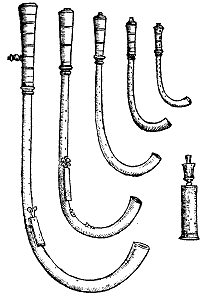 |
The Crumhorn and Rackett |
The Crumhorn is an odd instrument. It was always considered odd in England, and never really caught on, although it was more popular in the rest of Europe, particularly in Germany. Nicholas Lander (see the Links page) reckons that crumhorns existed from the 14th to 18th centuries, and I won't argue. The crumhorn is basically a small shawm, but it has two distinguishing features. Firstly, the reed is enclosed in a "windcap", or pressure chamber, which is just big enough to completely enclose the reed. Rather than hold the reed in the mouth, the player simply blows into the windcap mouthpiece, and the reed vibrates freely. It's similar to the bagpipe idea, but the "bag" is made of wood, and there are no drones. This largely eliminates any control over dynamics, but it makes it possible to play on horseback. That's not entirely a facetious remark - one of Dürer's illustrations shows crumhorns being played from a moving cart in a procession, where shawm players would be in danger of cracking their reeds at the first jolt, if not swallowing them. The crumhorn wasn't the only windcap instrument. It shared some of its history with sordunes, kortholts and bassanelli, all of which I may get round to writing about eventually. Please bookmark this site and pester me by email if I forget. The second distinguishing feature of crumhorns is that the lower end of the crumhorn is bent, in almost a semicircle. There are various explanations for this, none of which make much sense. The bend has to be formed after the bore is drilled, and even with modern technology, the bending process turns obscene quantities of otherwise good proto-crumhorns into firewood. Perhaps the crumhorn's ancestor was originally made with an attached cow horn like some early bagpipes, and when the all-wood crumhorn was developed, they kept the bend for sentimental reasons. Another theory is that the sound of a consort of crumhorns is so thick and rich that a player needs the end bent back up towards him so that he can hear what he's playing. My own theory is that it's simply a reflection of medieval trade guilds' restrictive practices - make it difficult, convince buyers that it's necessary, and no-one but a time-served guild apprentice can produce the goods. Modern reconstructions of crumhorns are mainly based on renaissance models. These had a parallel bore, with a very slight bell at the end. They were made in sizes from soprano to bass, of course. They make a pleasant, rich buzzing noise, and sound wonderful when played in consort, but they have a limited range (an octave and one note), which restricts them to simple dances and specially written easy consort pieces. They were therefore an excellent instrument for idle gentry who couldn't face the commitment required to play viols, and they are amply capable of fulfilling the same object nowadays, as a fair amount of music survives. Their greatest period of popularity was probably the early to middle sixteenth century. If you want an even richer sound, you need a contrabass instrument. I'm sure contrabass crumhorns were made, but there was another answer. Not long after the curtal was invented by "folding" a bass shawm, someone took the idea even further, and produced a folded contrabass shawmish thing. This time not two, but nine bores were drilled into a big, fat cylinder of wood, and joined at the top or bottom as appropriate to form a very long, winding bore in what looks to the uninitiated like a large wooden coffee jar. Working out where to drill finger-holes must have been a nightmare. The problem was cracked, but it meant, in places, drilling two or even three holes of different sizes into different bores, the holes emerging at the same place on the outside so that a single finger could cover them. Now that's technology. The bore was kept parallel, and there was no bell, so if I remember my physics right, that pushes the pitch down an octave. The result is a quiet instrument called a Rackett, which is less than a foot long, but gets notes half an octave below the curtal. Strictly speaking, it's not part of the crumhorn family, as it has an open reed like a shawm, but the sound is similar, and it makes an excellent contrabass to a crumhorn consort. The rackett has one major problem. Unlike other woodwind instruments, there's no easy way to mop out the excess water when you've finished playing it. Wooden instruments don't like being wet for long periods, and disaster can occasionally result. There is one 17th century report of a rackett "blowing up". It was probably just the wood splitting with a loud crack, but it caused great consternation to the owner. |
 Diabolus Homepage |
 Look up another Instrument |
 Email for Diabolus |
